
San Felipe de Neri Church is a historic Catholic church located on the north side of Old Town Plaza in Albuquerque, New Mexico. Built in 1793, it is one of the oldest surviving buildings in the city and the only building in Old Town proven to date to the Spanish colonial period. The church is listed on the New Mexico State Register of Cultural Properties and the National Register of Historic Places and has remained in continuous use for over 200 years.

St. John's Episcopal Church is a historic Episcopal church located on the village green in the village of Highgate Falls in Highgate, Vermont, in the United States. Built 1829–30, it is prominent local example of a Federal style church with Gothic Revival features. On September 3, 1976, it was listed on the National Register of Historic Places.

St. Anne's Episcopal Church is a historic church at 29 Church Street in Calais, Maine. Built in 1853, it is a locally distinctive example of Carpenter Gothic architecture, and is the only known statewide work of architect James Renwick Jr. The church building was listed on the National Register of Historic Places in 1982. It is a member of the Episcopal Diocese of Maine; its pastor is the Rev. Sara Gavit.
The Indian River Baptist Church is a historic former church building on Maine State Route 187, near its crossing of the Indian River in Addison, Maine. Built in 1853-54, it is one of the community's most sophisticated architectural structures, exhibiting transitional Greek Revival and Italianate styling. It was listed on the National Register of Historic Places in 1988. The building is now maintained by a local nonprofit organization.
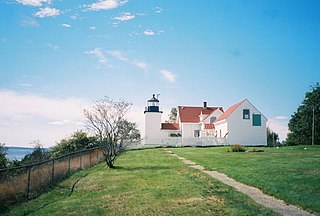
The Fort Point Light, or Fort Point Light Station, is located in Fort Point State Park, in Stockton Springs, Maine. A lighthouse at this point has served as an active aid to navigation since 1835; the present lighthouse dates to 1857, and is listed on the National Register of Historic Places.
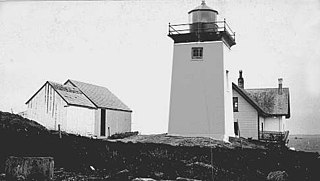
Indian Island Light is a lighthouse on Indian Island on the eastern side of the entrance to Rockport Harbor, Maine. It was first established in 1850. The present structure was built in 1875. It was deactivated in 1934 and is now a private residence. It was listed on the National Register of Historic Places as Indian Island Light Station on March 23, 1988.
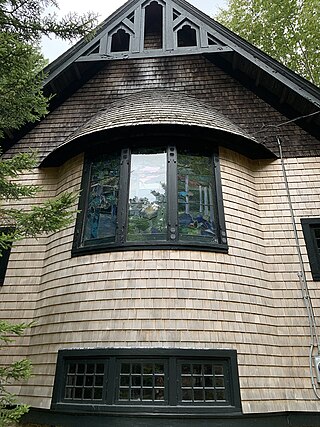
Saint Jude's Episcopal Church is a historic church at 277 Peabody Drive in Seal Harbor, Maine. Built in 1887–89, this Shingle-style church is the least-altered surviving example of ecclesiastical architecture in Maine designed by the noted exponent of the style, William Ralph Emerson. Principally used as a summer chapel, it is affiliated with the Episcopal mission of St. Mary's in Northeast Harbor. The building was listed on the National Register of Historic Places in 1986.

St. Mary's Church is a Roman Catholic church at 41 Western Avenue in Augusta, Maine. Built in 1926, it is one of the city's finest examples of Gothic Revival architecture. It was listed on the National Register of Historic Places in 1987.
Dexter Universalist Church, or the First Universalist Church of Dexter, is a historic church on Church Street in Dexter, Maine. Built in the 1820s and restyled in the 1860s, it is a distinctive work of Boston, Massachusetts architect Thomas Silloway. The building was listed on the National Register of Historic Places in 1985.
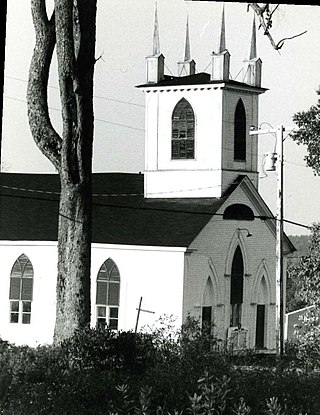
The Dixmont Corner Church is a historic church on United States Route 202 in Dixmont, Maine. Built in 1834–35, it is one of the oldest churches in rural Penobscot County, and one of its earliest examples of Carpenter Gothic architecture. It was listed on the National Register of Historic Places in 1983.
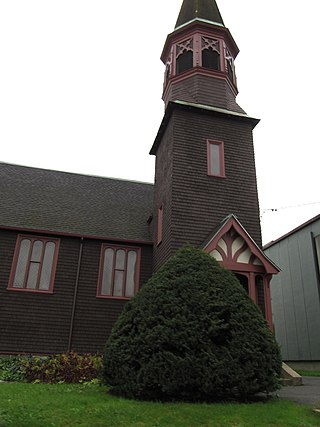
St. James Episcopal Church is a historic church at Center and Main Streets in the heart of Old Town, Maine. Built in 1892, the church is one of four works in the state designed by the Gothic Revival specialist Henry Vaughan. It is one of Old Town's few 19th century landmarks, and was listed on the National Register of Historic Places in 1974. Its current minister is the Rev. Jane White-Hassler.

St. John's Catholic Church is a historic church at 217 York Street in Bangor, Maine. Built in 1855 at the height of the anti-immigrant Know Nothing movement, it stands as a major symbol of the city's Irish-American heritage, and a high quality local example of Gothic Revival architecture. It was listed on the National Register of Historic Places in 1973.
The Springfield Congregational Church is a historic church on Maine State Route 6 in Springfield, Maine. Built in 1852, it is Gothic Revival building noted for its elegance and high quality despite its rural setting. The building was listed on the National Register of Historic Places in 1978.

St. Mary's Catholic Church is a parish church of the Diocese of Davenport. The church is located at the corner of St. Mary's and Washburn Streets in the town of Riverside, Iowa, United States. The entire parish complex forms an historic district listed on the National Register of Historic Places as St. Mary's Parish Church Buildings. The designation includes the church building, rectory, the former church, and former school building. The former convent, which was included in the historical designation, is no longer in existence.

The Zeba Indian United Methodist Church is a religious building located at 227 Front Street in Zeba, Michigan, northeast of L'Anse. It marks the site of the Kewawenon Mission, built in 1832, which was the birthplace of Indian Methodism in the western Upper Peninsula, and predated Frederic Baraga's mission at Assinins by 11 years. It was listed on the National Register of Historic Places in 1980 and designated a Michigan State Historic Site in 1979.
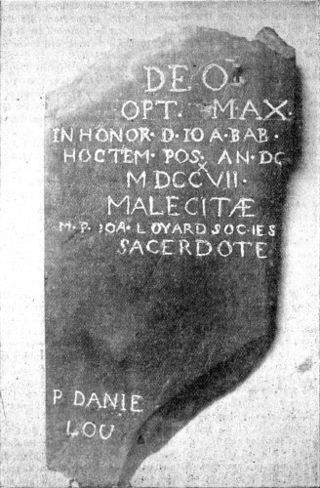
Meductic Indian Village / Fort Meductic was a Maliseet settlement until the mid-eighteenth century. It was located near the confluence of the Eel River and Saint John River in New Brunswick, four miles upriver from present-day Lakeland Ridges. The fortified village of Meductic was the principal settlement of the Maliseet First Nation from before the 17th century until the middle of the 18th, and it was an important fur trading centre..

St. Francis Solanus Mission is a historic mission on W. Lake Street in Petoskey, Michigan. It is the only existing building in the Arbre Croche district dating from the time of Bishop Frederic Baraga, and is the oldest building still standing in Petoskey, as well as one of the oldest in northern lower Michigan. The mission was added to the National Register of Historic Places in 1972.

St. Augustine Catholic Church and Cemetery is a historic site in Hartland, Michigan. It is associated with Fr. Patrick O’Kelly, a missionary priest who was active in Southeastern Michigan. The church was built in 1843 and added to the National Register in 1996.

All Souls Congregational Church is an historic church at 10 Broadway in Bangor, Maine. Built in 1911, it is a landmark in the city, designed by the noted proponent of the Gothic Revival, Ralph Adams Cram. It was listed on the National Register of Historic Places in 1992. The church is affiliated with the United Church of Christ; the current pastor is Rev. Chad L. Poland.

The Oratory of St. Patrick, also known as St. Patrick's Roman Catholic Church is a historic Roman Catholic church located at Lagro, Wabash County, Indiana. It was listed on the National Register of Historic Places in 1999.



















